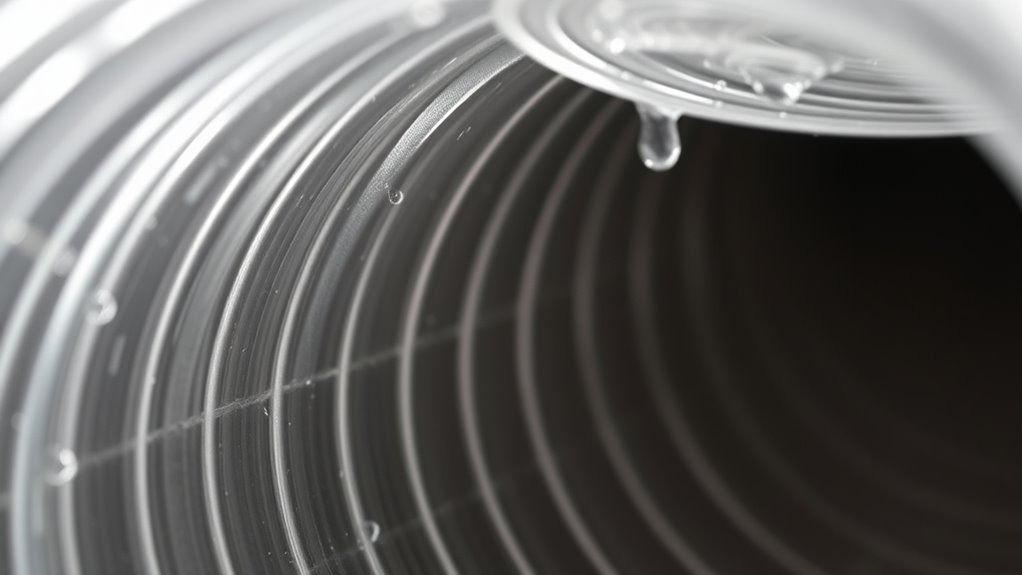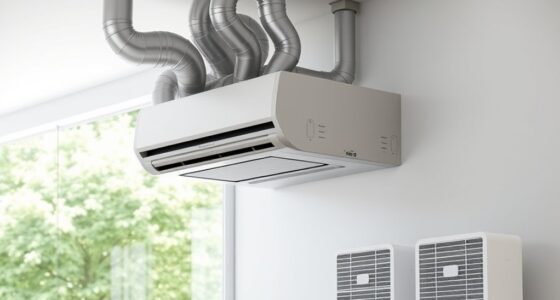To prevent mold in your HVAC ductwork, ensure proper airflow by regularly checking and sealing vents and duct connections. control indoor humidity levels between 30-50% to reduce moisture that promotes mold growth. Schedule routine inspections and professional cleanings to remove dust and debris that feed mold. Also, change filters every 1-3 months, using high-efficiency ones if possible. Keeping these factors in check helps safeguard your health and air quality; continue with this guide to learn more about effective mold prevention strategies.
Key Takeaways
- Regularly inspect and clean HVAC ducts to remove dust, debris, and organic matter that promote mold growth.
- Maintain indoor humidity levels between 30-50% to prevent excess moisture that supports mold development.
- Replace or upgrade filters frequently with high-efficiency filters like HEPA to trap mold spores effectively.
- Seal duct connections and vents to prevent outside humidity and moisture from entering the system.
- Ensure proper airflow throughout the system to reduce condensation and inhibit mold proliferation.

Mold in HVAC ductwork can pose serious health risks and reduce indoor air quality, making prevention essential. When mold grows inside your ducts, it releases spores into the air you breathe, which can trigger allergies, asthma, and other respiratory issues. To keep your indoor environment safe, you need to focus on maintaining proper airflow and regularly inspecting and replacing filters. These steps are key to preventing mold growth and ensuring your HVAC system runs efficiently.
Prevent mold in HVAC ducts by maintaining airflow, inspecting, and replacing filters regularly for healthier indoor air.
Optimizing airflow is critical because stagnant air promotes moisture buildup, creating a perfect environment for mold to thrive. You should ensure your vents and registers aren’t blocked by furniture or dust accumulation. Properly sealed duct connections prevent outside humidity from seeping in and causing dampness inside the ducts. Keeping airflow consistent helps reduce condensation, which is often the initial trigger for mold growth. If you notice uneven airflow or weak spots in your system, addressing these issues promptly can considerably lower mold risk.
Filter maintenance plays a pivotal role in mold prevention. Your air filters trap dirt, dust, and other airborne particles, including mold spores. When filters become dirty or clogged, airflow drops, and moisture can settle within the system, creating an ideal environment for mold. Regularly replacing or cleaning your filters—typically every 1 to 3 months—ensures your HVAC system functions properly and doesn’t become a breeding ground for mold. High-efficiency filters, such as HEPA filters, are especially effective at capturing mold spores, providing an extra layer of protection.
Along with airflow optimization and filter maintenance, it’s essential to keep the ductwork itself clean. Over time, dust, pet dander, and organic debris can accumulate, providing nutrients for mold. Regularly inspecting your ducts for signs of mold or excessive dust and scheduling professional cleanings can prevent mold from taking hold. Additionally, controlling indoor humidity levels—ideally between 30-50%—helps prevent moisture accumulation, further inhibiting mold development.
In essence, preventing mold in your HVAC ductwork requires active management of airflow, diligent filter maintenance, and routine inspections. By keeping air moving smoothly and maintaining clean filters, you reduce moisture and airborne mold spores. These simple yet effective steps protect your health and ensure your indoor air quality remains high. Taking proactive measures now can save you from costly mold remediation later, giving you peace of mind in a healthier living environment.
Frequently Asked Questions
How Often Should HVAC Ducts Be Inspected for Mold?
You should inspect your HVAC ducts for mold at least once a year, especially if you have mold risk factors like high humidity, allergies, or recent water damage. Regular inspections help catch mold early before it spreads or causes health issues. If you notice musty odors or visible mold, increase inspection frequency. Staying proactive keeps your system clean and reduces mold growth, protecting your home’s air quality and your family’s health.
Are There Eco-Friendly Mold Prevention Options for Ductwork?
Sure, eco-friendly mold prevention options exist—who knew? You can use natural antimicrobials like tea tree oil or vinegar, which are surprisingly effective and gentle on the environment. Eco-friendly treatments help keep your ductwork mold-free without harsh chemicals. Regular inspections combined with these natural solutions make your HVAC system safer and greener. So, yes, you can protect your ducts while being kind to the planet with simple, natural antimicrobials.
Can Duct Cleaning Alone Prevent Mold Growth?
Duct cleaning alone can’t fully prevent mold growth, but it plays a vital role in maintaining good air quality. Regular duct maintenance removes dust, debris, and mold spores, reducing the chances of mold thriving. To effectively prevent mold, combine duct cleaning with controlling humidity levels and addressing leaks. This all-encompassing approach ensures your HVAC system stays clean, and your indoor air remains healthy and mold-free.
What Are the Health Risks of Mold in HVAC Ducts?
Have you ever wondered what mold lurking in your HVAC ducts can do? Mold can cause serious health risks, including mold-related illnesses like respiratory issues, asthma, and infections. It also acts as allergy triggers, worsening symptoms for allergy sufferers. Breathing in mold spores regularly can compromise your immune system and overall well-being. Stay alert and make sure your ducts are properly maintained to prevent these health hazards from affecting you and your family.
Do All Types of Mold Pose the Same Health Threat?
Not all mold poses the same health threat, as mold toxicity varies by type. Some molds release harmful mycotoxins that can cause allergic reactions, respiratory issues, or even more severe health problems. Proper mold identification is essential to establish its danger. If you suspect mold in your HVAC ducts, have a professional assess it promptly, so you can address any potential health risks and ensure a safe indoor environment.
Conclusion
By keeping your HVAC ductwork clean and dry, you’re fundamentally planting a shield against mold’s silent invasion. Think of your ducts as the roots of your home’s health—if you nurture them with care, mold can’t take hold and spread. Regular maintenance is your armor, turning your system into a fortress of freshness. When you prioritize prevention, you’re not just protecting your air; you’re safeguarding the breath of your home’s soul.









